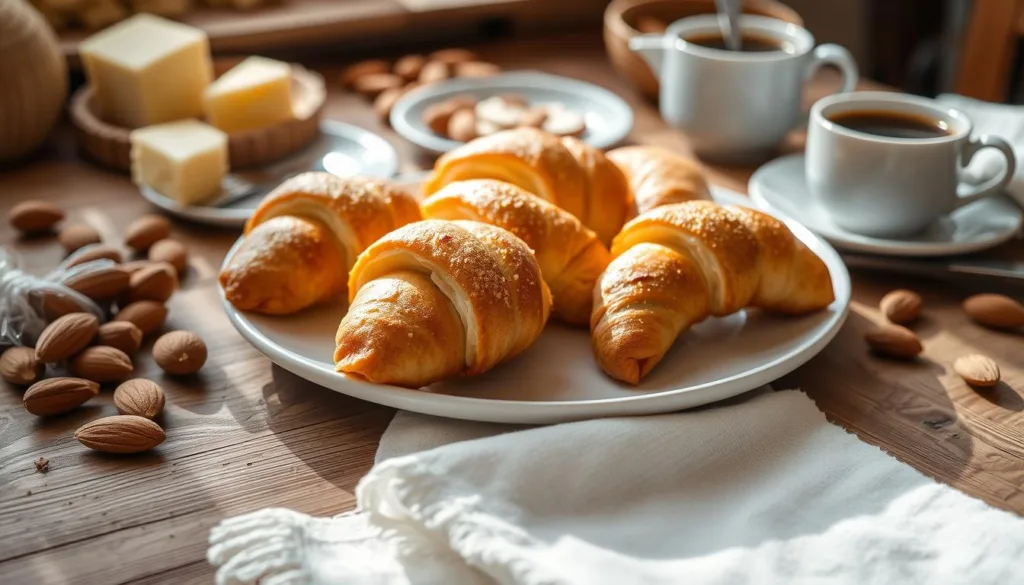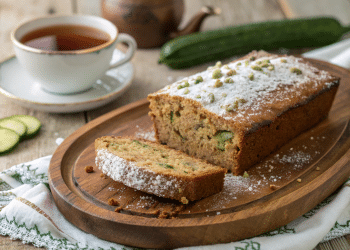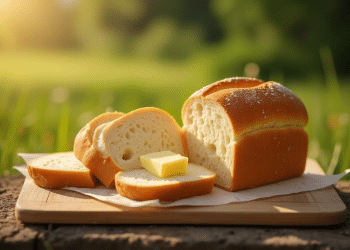Imagine a Swiss village filled with the sweet smell of pastries. It’s a place where the gipfeli recipe, a Swiss favorite, is enjoyed. This pastry is like a croissant but flakier and buttery, with a soft brioche texture.
When you take a bite, you feel like you’re in Switzerland. Here, old traditions meet new ideas in a delicious way. It’s a treat that you won’t forget.

Key Takeaways
- Gipfeli are a Swiss version of the classic croissant, with a unique flaky and buttery texture.
- The recipe combines traditional Swiss baking techniques with the richness of brioche dough.
- Gipfeli are a beloved breakfast and snack item in Switzerland, with a long and storied cultural history.
- Mastering the art of gipfeli baking requires attention to detail, from kneading the dough to shaping and proofing the pastries.
- Gipfeli can be enjoyed in a variety of sweet and savory variations, making them a versatile and delightful treat.
The Art of Crafting Gipfeli recipe
Making the perfect flaky butter bread or buttery swiss pastry like gipfeli is an art. Swiss bakers have perfected it over generations. These european breakfast pastries are famous for their light, layered texture and rich taste. We’ll look at the techniques and traditions behind these Swiss treats.
Flaky Layers and Buttery Goodness
The secret to gipfeli’s flaky and buttery taste is in the lamination process. Swiss bakers fold and roll the dough carefully. This creates dozens of thin layers that turn into a light, airy pastry when baked.
This special technique makes gipfeli stand out. It gives a unique and satisfying taste experience.
Traditional Techniques for Modern Bakers
- Proper kneading and resting of the dough to develop gluten structure
- Precise temperature control during the lamination process
- Employing traditional tools like wooden rolling pins for a gentle touch
- Maintaining the perfect balance of butter and dough for flaky perfection
By learning and using these old techniques, home bakers can make traditional gipfeli at home. They can bring a taste of Switzerland to their breakfast.
“The secret to the perfect gipfeli is in the delicate balance of flaky layers and rich, buttery goodness.”
Gipfeli Recipe: A Step-by-Step Guide
Making the perfect gipfeli, a Swiss croissant-style pastry, is fun and rewarding. Follow this guide to make your own flaky, buttery gipfeli at home.
Begin by making the gipfeli dough. Mix flour, yeast, salt, and sugar in a big bowl. Add warm milk and melted butter slowly. Knead until it’s smooth and elastic. Then, cover it and let it rest for an hour to develop the gluten.
- After resting, roll the dough thin on a floured surface.
- Fold it into thirds like a letter, then in half to make a square. This creates the braided brioche layers.
- Keep folding and rolling, chilling the dough for 30 minutes each time. This keeps the butter from melting.
- After the last fold, roll it into a long, thin rectangle, about 1/4 inch thick.
- Cut into triangles and roll each up from the wide end to the point.
- Place the rolled gipfeli on a baking sheet, cover, and let rise for 30 minutes.
- Preheat your oven to 400°F (200°C). Bake for 15-20 minutes, until golden and flaky.
Serve your gipfeli warm for the best taste. With practice, you’ll soon be a pro at making this Swiss treat!
Mastering the Gipfeli Dough
Making the perfect gipfeli starts with the dough. This step is key for flaky layers and buttery taste. Let’s explore kneading, proofing, and shaping your dough.
Kneading for Perfection
Kneading the gipfeli dough is crucial. Use a gentle yet firm touch to work the gluten. This makes the dough tender and chewy.
Follow the brioche bread instructions for the right mix of richness and lightness.
Proofing and Shaping Secrets
Let the gipfeli dough proof after kneading. This step lets the yeast make it rise and flavor it. When it’s doubled, shape your gipfeli.
Try braided brioche to make the crescent-shaped pastries. They will amaze your taste buds.
“The secret to a perfect gipfeli lies in the patient mastery of the dough. With the right techniques, you can unlock the full potential of this Swiss delight.”
Mastering kneading, proofing, and shaping will help you make amazing gipfeli. Dive into the art of gipfeli-making and improve your baking skills.
Ingredients: Quality Matters
Creating the perfect gipfeli, swiss butter braid, or swiss brioche starts with top-notch ingredients. These pastries need the best, freshest parts to get that flaky texture and buttery taste. Let’s look at the key ingredients for a delicious gipfeli.
The Butter Factor
The heart of a great gipfeli is the butter. Choose a high-quality, European-style butter with creamy, low-moisture content. This ensures your pastry layers are perfectly laminated and melt-in-your-mouth delicious. Don’t use standard American butter, as it can make the pastry greasy and heavy.
Flour Power
The flour you pick is crucial for your gipfeli. Go for a high-protein, low-gluten flour like bread flour or all-purpose flour. This gives the right mix of strength and tenderness. Stay away from self-rising flour, as it can make the pastry dense and heavy.
- Bread flour: Provides structure and chewiness
- All-purpose flour: Delivers a more tender, delicate crumb
The Finishing Touches
Other important ingredients for gipfeli include fresh eggs, a bit of sugar, and a pinch of salt. These add the perfect balance of richness, sweetness, and flavor to your pastry.
“The secret to a truly remarkable gipfeli lies in the quality of your ingredients. Invest in the best, and your pastries will shine.”
Remember, when making gipfeli, swiss butter braid, and swiss brioche, quality is key. By using the finest ingredients, you’ll create a pastry masterpiece that will wow your senses and impress your guests.
Tools of the Trade: Gipfeli Essentials
To make the perfect gipfeli, or Swiss croissant-style pastries, you need the right tools. Creating these European breakfast pastries at home requires a dedicated baking station. Let’s look at the must-have tools for your gipfeli recipe journey.
Equipping Your Gipfeli Baking Station
At the heart of your gipfeli baking station, a reliable stand mixer is key. This powerful tool makes kneading the dough easy, ensuring flaky texture. You’ll also need high-quality rolling pins for thin, even layers, just like authentic gipfeli.
For shaping and cutting the dough, a sturdy pastry board and sharp dough scraper are crucial. These tools help you measure and cut the dough into crescent shapes. Remember a trusty pastry brush for that golden-brown egg wash finish.
- Stand mixer for kneading the dough
- High-quality rolling pins for creating thin, even layers
- Pastry board and dough scraper for shaping and cutting
- Pastry brush for applying the egg wash
With these essential tools in your gipfeli baking station, you’re ready to make delicious traditional gipfeli in your kitchen.
Gipfeli: A Taste of Switzerland
Gipfeli, the beloved traditional gipfeli pastry, is a big part of Swiss culture. Both locals and visitors love it. This flaky, buttery treat has been a favorite on European breakfast tables for centuries.
Cultural Significance and History
The history of gipfeli goes back to the 18th century. Swiss bakers worked hard to perfect these European breakfast pastries. The name “gipfeli” comes from the German word “Gipfel,” meaning “peak” or “summit,” because of their crescent shape.
Gipfeli are a big part of Swiss culture. They’re not just for breakfast but also a symbol of Swiss culinary traditions. These flaky treats are a big part of Swiss life and celebrations.
“Gipfeli are not just a pastry – they are a piece of Switzerland, savored with every bite.”
Making gipfeli is a tradition passed down through generations. Bakers use old techniques to make these pastries special. Each gipfeli shows the skill and dedication of Swiss bakers.
Gipfeli are enjoyed in Swiss cafes and as a midday treat. They’re a big part of Switzerland’s food scene. Their popularity shows how much people love this traditional gipfeli pastry.
Innovative Gipfeli Twists
Modern bakers are making the traditional gipfeli, or Swiss croissant-style pastry, even better. They’re adding new flavors and fillings. This lets both home cooks and professionals show off their skills.
Sweet and Savory Variations
One cool twist is adding unique flavors to the gipfeli recipe. Think about a flaky, buttery swiss brioche filled with chocolate, hazelnut, or lemon curd. For something savory, try fillings like aged cheese, caramelized onions, or herbs and spices.
The braided brioche is another creative take. It’s made by weaving the dough into a beautiful design. This not only looks great but also makes the pastry flaky and textured.
These modern gipfeli creations are a feast for the senses. They offer amazing smells, colors, and tastes. They’re a great way to make the traditional Swiss pastry even more exciting.
“The beauty of gipfeli is that it serves as a blank canvas for the culinary artist. From sweet to savory, the possibilities are truly endless.”
So, why not try something new with gipfeli? It’s a chance to explore new flavors and have fun in the kitchen.
Baking Tips for Flawless Gipfeli
Making perfect gipfeli, a Swiss croissant-style pastry, is an art. It needs precision and attention to detail. This guide will help you bake gipfeli that are flaky, buttery, and irresistible.
Keeping the right temperature is key for gipfeli success. Make sure your oven is preheated correctly. Also, don’t open the oven door too often, as it can ruin the dough. Using an oven thermometer is a good idea to check the temperature.
Shaping and lamination are crucial for the perfect layers. Roll and fold the dough gently to keep the layers intact. Don’t overwork the dough, as it can make it tough. Instead, use the “turn” technique to create flaky, buttery layers.
FAQ
What is a gipfeli?
A gipfeli is a Swiss pastry that looks like a croissant. It’s known for its flaky, buttery layers and rich taste.
What makes gipfeli unique?
Gipfeli are made with a special Swiss technique. This makes them flaky and buttery. They’re a favorite breakfast treat in Switzerland and Europe.
How do I make gipfeli at home?
Making gipfeli at home is a multi-step process. You’ll mix the dough, chill it, laminate, and shape the pastries before baking. Our guide has all the steps you need to make them in your kitchen.
What ingredients are needed for gipfeli?
To make gipfeli, you need high-quality butter, flour, eggs, sugar, and yeast. Using the best ingredients is key for their signature texture and flavor.
What equipment is required to make gipfeli?
You’ll need basic baking tools like a stand mixer, rolling pin, baking sheets, and parchment paper. Having a dedicated baking station can make the process easier and ensure great results.
Can I make variations on the traditional gipfeli recipe?
Yes! You can add your own twist to the classic gipfeli recipe. Try different sweet or savory fillings to make it your own.
What tips can I follow to ensure my gipfeli turn out perfectly?
Making perfect gipfeli takes practice. But, following some key tips can help. Proper kneading, precise proofing, and careful shaping are important. Our guide also offers advice for any challenges you might face.
What is the cultural significance of gipfeli?
Gipfeli are deeply rooted in Swiss culture. They’re a beloved breakfast item and a big part of Swiss culinary tradition. They’re enjoyed for their delicious taste and the nostalgia they bring.














